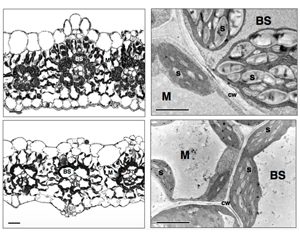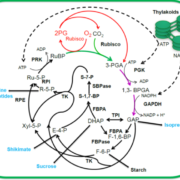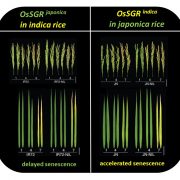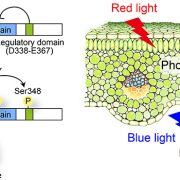Diffusion of CO2 across the mesophyll-bundle sheath cell interface in a C4 plant with genetically reduced PEP carboxylase activity (Plant Physiol.)
 C4 photosynthesis relies on the transport of carbon (in the form of C4 acids) from the mesophyll into bundle sheath cells (BSCs). Subsequent decarboxylation of these C4 acids generates a high concentration of CO2 in the vicinity of Rubisco, helping to improve the catalytic efficiency of this enzyme. However, carbon can also enter BSCs via direct CO2 diffusion from the mesophyll – the passage of CO2 across this interface is termed bundle sheath conductance (gbs). In this research, Alonso-Cantabrana et al. used RNAi to target mesophyll phosphoenolpyruvate carboxylase (PEPC) in Setaria viridis. PEPC performs the initial fixation of CO2 from the air in the C4 system, and so in its absence, direct diffusion represents the major source of CO2 for Rubisco in BSCs. In the resulting plants, the authors were able to determine gbs, and also examine the mesophyll-BSC interface to establish the anatomical response to the introduced lesion. Gas exchange data showed that in the absence of PEPC, Rubisco appeared to be fixing CO2 directly, while plasmodesmatal density was increased in the low-PEPC plants, potentially as a compensation mechanism to allow higher CO2 flux into BSCs. This also represents a route for increased CO2 leakage from BSCs, which would normally be recycled by PEPC in the mesophyll. Investigation of the signalling pathways involved in this response represents a challenging next step in determining how gbs is modulated. (Summary by Mike Page) Plant Physiol. 10.1104/pp.18.00618
C4 photosynthesis relies on the transport of carbon (in the form of C4 acids) from the mesophyll into bundle sheath cells (BSCs). Subsequent decarboxylation of these C4 acids generates a high concentration of CO2 in the vicinity of Rubisco, helping to improve the catalytic efficiency of this enzyme. However, carbon can also enter BSCs via direct CO2 diffusion from the mesophyll – the passage of CO2 across this interface is termed bundle sheath conductance (gbs). In this research, Alonso-Cantabrana et al. used RNAi to target mesophyll phosphoenolpyruvate carboxylase (PEPC) in Setaria viridis. PEPC performs the initial fixation of CO2 from the air in the C4 system, and so in its absence, direct diffusion represents the major source of CO2 for Rubisco in BSCs. In the resulting plants, the authors were able to determine gbs, and also examine the mesophyll-BSC interface to establish the anatomical response to the introduced lesion. Gas exchange data showed that in the absence of PEPC, Rubisco appeared to be fixing CO2 directly, while plasmodesmatal density was increased in the low-PEPC plants, potentially as a compensation mechanism to allow higher CO2 flux into BSCs. This also represents a route for increased CO2 leakage from BSCs, which would normally be recycled by PEPC in the mesophyll. Investigation of the signalling pathways involved in this response represents a challenging next step in determining how gbs is modulated. (Summary by Mike Page) Plant Physiol. 10.1104/pp.18.00618









